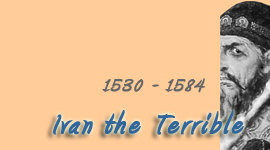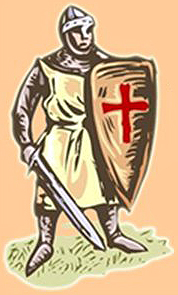|

 Explorers, Scientists &
Inventors
Explorers, Scientists &
Inventors
 Musicians, Painters &
Artists
Musicians, Painters &
Artists
 Poets, Writers &
Philosophers
Poets, Writers &
Philosophers
 Native Americans & The Wild
West
Native Americans & The Wild
West
 First Ladies
First Ladies
 Popes
Popes
 Troublemakers
Troublemakers
 Historians
Historians
 Archaeologists
Archaeologists
 Royal Families
Royal Families
 Tribes & Peoples
Tribes & Peoples

Assassinations in History
Who
got slain, almost slain, when, how,
why, and by whom?
 Go to the
Assassination Archive
Go to the
Assassination Archive




Online History Dictionary A - Z
All-Time Records in
History
What was the
bloodiest battle, the battle with the least
casualties, who was the greatest military leader?
 Go to
Records in History
Go to
Records in History

|
|
Haitian Revolution 1791-1804
The Haitian Revolution is also called the
Saint
Domingue Slave Rebellion.
|
|
When Did the Haitian Revolution Begin?
The revolt of the slaves on Saint Domingue (today's
 Haiti), begun on the night of
August 22 to 23, 1791. Haiti), begun on the night of
August 22 to 23, 1791.
The plantation owners turned to England for help, whereas Spain (who
occupied the right half of Hispaniola) was aiding the slaves.
The outcome of this slave uprising had an effect on all European
colonies, and it played a crucial role in the abolition of the
transatlantic slave trade.
 Check this event in the timeline of
the French Revolution
Check this event in the timeline of
the French Revolution
Who Were the Leaders of the Haitian Revolution?
Jean-François and
Georges Biassou,
Toussaint Louverture,
Jean-Jacques
Dessalines, Alexandre Pétion,
Henry Christophe
Who Were the Maroons?
Originally, the term maroon referred
to fugitive or runaway slaves, then ex-slaves, mainly in Suriname and
the West Indies.
Later, the term was also used to refer
to a
descendant of such a slave.
The word maroon might or might
not derive from the Spanish
cimarrón, meaning wild or savage.
|
The Haitian Revolution Builds
In October 1790, the wealthy mulatto
Vincent Ogé and Jean-Baptiste
Chavannes started an uprising, also known as the
Mulatto Revolt. It was crushed
with the quickness and at the end of November 1790, Oge was
captured.
Check this event in the
 timeline of the French Revolutionary Wars.
timeline of the French Revolutionary Wars.
On May 11, 1791, before the
 National Constituent Assembly,
Lafayette spoke in favor of abolition of the slave trade.
National Constituent Assembly,
Lafayette spoke in favor of abolition of the slave trade.
 Check this event in the timeline of the French
Revolution.
Check this event in the timeline of the French
Revolution.
On May 13, 1791, the National Constituent Assembly decreed the
continuation of slavery, at the discretion of the colonists.
 Check this event in the timeline of the French
Revolution.
Check this event in the timeline of the French
Revolution.
The Haitian Revolution Takes Its Course
The law of April 4, 1792,
concerning the French colonies, decreed that
"Men of color and free negroes are admitted
to vote in every parish assemblies, and are
eligible to all places."
But on Saint Domingue this law was largely
ignored.
To address this issue, France sent a
commission of three representatives,
Léger-Félicité
Sonthonax,
Etienne Polverel and
Jean-Antoine
Ailhaux (or Ailhaud).
On August 29, 1793, Sonthonax declared the
emancipation of the slaves.
But apparently, Sonthonax soon tried to
abuse his power for his own gain, and in
1797, Toussaint sent him home.
On February 3, 1794, a committee from Saint
Domingue (Louis-Pierre
Dufay de la Tour, white,
Jean-Baptiste Mills,
of mixed race, and
Jean-Baptiste Belley, black) is
allowed before the Convention at Paris.
Check
 this event in the
timeline of the French Revolutionary Wars.
this event in the
timeline of the French Revolutionary Wars.

Jean-Baptiste Belley in 1797
First portrait of a black man in the
position of a western legislator.
Belley leans against a marble bust of
Abbé Guillaume
Thomas de Raynal,
a French philosopher known for his
opposition to violence and his anti-slavery
views.
In the background we see the landscape of
the mountains in the north of
Saint Domingue near Cape French and even
white smoke from a sugar refinery
and the sea on the horizon.
Oil on canvas by Anne-Louis Girodet de
Roussy-Trioson
Versailles, Photo RMN / © Gérard Blot
At this occasion, the deputy of Eure-et-Loir,
Jean-Francois
Lacroix, asked for permission to
get emotional:
Since a
long time, the Assembly wanted at its bosom
men of color, who were oppressed for so many
years. Today, it has two. I ask that their
introduction is marked by the fraternal
embrace of the president.

Jean-François Lacroix, who lived 1753-1 794
Deputy of Eure-et-Loir from 1791-1794
Assemble-Nationale.fr
Everyone cheered, the three deputies from
Saint Domingue approached the president of
the National Convention,
Marc Guillaume
Vadier. Put on the spot, Vadier received the deputies with a fraternal
kiss, after which the meeting hall again
applauded and cheered.
Under applause and shouts of Vive la
république! Vive la Convention! Vive la
Montagne! the two deputies of color are
successively embraced by all members of the
Convention.

Marc Vadier, who lived 1736-1828
President of the French National Convention
from January 20, 1794, until February 4,
1794.
Assemble-Nationale.fr
The very next day, February 4, 1794, Dufay
spoke before the Convention and described
the oppression, the humiliation, and the
horror of the condition of the slaves at
Saint Domingue.
Dufay's speech was followed by
 Georges Danton's
remarks, who under applause called for
"universal freedom."
Georges Danton's
remarks, who under applause called for
"universal freedom."
Then, the Convention decreed the abolition
of slavery.
On February 6, 1794, Dufay wrapped it up
with a speech, noting that the citizens of
color ARE the people, in fact, they are the
REAL
 sans-culottes.
sans-culottes.
Napoleon came to power and, in January 1802,
he sent his brother-in-law,
Charles Leclerc,
and 23,000 French troops to end the
revolution. Traveling with Leclerc was his
wife, Pauline
Bonaparte, Napoleon's younger
sister.
Leclerc arrested Toussaint and shipped him
to France, where, at Fort-de-Joux, he died
in April 1803.
Leclerc himself had already died of yellow
fever on November 2, 1802.
On January 1, 1804, Saint Domingue declares
its independence and takes the name Haiti.
Slavery After the Haitian Revolution
After the first abolition of slavery in 1794, slavery was finally
completely abolished on April 27, 1848.
Whereas slavery is an attack on human
dignity,
destroying the free agency of man,
removing the principle natural right and
obligation,
being a flagrant violation of the Republican
dogma: Liberty, Equality, Fraternity,
it is declared that slavery
is completely abolished in all French
colonies and possessions.
And here is the key moment of the Haitian Revolution:

Oath of the Ancestors, Serment des Ancêtres
Painting by Guillaume Guillon Lethière 1822
Massive Oil on canvas 300 cm x 400 cm
About this Painting
According to the Summary of the Main Measures Proposed by France
in Aid of Haiti's Reconstruction Communiqué Issued by the Presidency
of the Republic, issued at Paris on February 27, 2010:
this portrays the historic meeting between
the leader of the Santo Domingo mulattos,
Alexandre Pétion, and the black General
Jean-Jacques Dessalines, Toussaint
Louverture's lieutenant.
In November 1802,
the two officers sealed an alliance to chase
out the French troops shortly after
Bonaparte's decision to restore slavery.
The
picture was damaged in the collapse of the
National Palace, salvaged from the rubble by
a French team and has since been stored on
the site of the French embassy.
The painter was born in Guadeloupe. His father was a white settler,
in fact he was the public prosecutor in Guadeloupe, his mother was a
freed black slave from Guadeloupe.
And according to Nathalie Jolivert ...
...
The painting celebrates the union of Black
and Mulatto slaves against Napoleon’s army
by staging upfront the Haitian Independence
heroes Jean-Jacques Dessalines and Alexandre
Pétion.
Oath of the Ancestors not only
eternalizes the collaboration that has
defeated the imperialists' strategy to "divide and conquer" but it also symbolizes
the complicated relationship between an
emancipated people and its former authority
figure, by showing in prominence a White
figure acknowledging the sacred moment.
...
From the way the Oath of Our Ancestors was
smuggled out of France into Haïti’s Catholic
cathedral in 1822, to its present
restoration in France after it was buried
under the Haitian Presidential Palace during
the earthquake of January 12, 2010,
Lethiere's piece captures a meaningful
moment in history, which remains relevant to
many aspects of our evolving world of
freedom.
 Here is more about Nathalie Jolivert
Here is more about Nathalie Jolivert
This is an excerpt from the Daily Chronicle, article from February
16, 2010:
Nicolas
Sarkozy's visit Wednesday, the first ever by
a French president, is reviving bitter
memories of the crippling costs of Haiti's
1804 independence.
A third of the population was killed in an
uprising against exceptionally brutal
slavery, an international embargo was
imposed to prevent slave revolts elsewhere
and 90 million pieces of gold were demanded
by Paris from the world's first black
republic.
The debt hobbled Haiti, it seemed for life.
...
France
has already said it was canceling all of
Haiti's 56 million euro (US$77 million) debt
to Paris.
...
But
Haiti's wealth already was destroyed. It had
been the world's richest colony, providing
half the globe's sugar and other exports
including coffee, cotton, hardwood and
indigo that exceeded the value of everything
produced in the United States in 1788.
By the early 1780s, half of Haiti's forests
were gone, leading to the devastating
erosion and extreme poverty that bedevils
the country today.
The human cost of the colonial exploitation
was staggering. Slaves lasted little more
than 10 years under brutal conditions.
Haitian slaves who displeased their masters
were boiled to death in vats of molasses,
buried alive in piles of biting insects,
crushed by heavy stones or simply starved to
death. Just before the rebellion, Haiti had
some 450,000 slaves, 25,000 whites and
several thousand freed blacks and a
mixed-race elite.
The uprising was as brutal as what had gone
before.
Haitians asked about their independence
today quickly recall the bloody Creole
slogan koupe tet, boule kay — cut off
their heads, torch their houses.
...
Many
remain wary, however, in a country where
people still describe a deceitful politician
as "speaking French." The vast majority of
Haitians speak Creole.

French military rescue workers standing by the
painting Serment des Ancetres
(Oath of the
Ancestors), by Guillaume Guillon Lethiere,
at
the presidential palace in Port au Prince,
Haiti.
France's Culture Minister says Louvre art
restoration experts will repair the 1822
painting found in the rubble of the Caribbean
country's presidential palace.
The painting
depicts a meeting between two of the fathers of
Haitian independence. Haiti won its independence
in an 1804 slave revolt against France,
defeating Napoleon's forces. (AP photo)
 Here you can read the
entire article.
Here you can read the
entire article.
Here is an excerpt from an article published by the Library of
Congress:
The National
Assembly in Paris required the white
Colonial Assembly to grant suffrage to the
landed and tax-paying gens de couleur. (The
white colonists had had a history of
ignoring French efforts to improve the lot
of the black and the mulatto populations.)
The Assembly refused, leading to the first
mulatto rebellion in Saint-Domingue. The
rebellion, led by Vincent Ogé in 1790,
failed when the white militia reinforced
itself with a corps of black volunteers.
(The white elite was constantly prepared to
use racial tension between blacks and
mulattoes to advantage.) Ogé's rebellion was
a sign of broader unrest in Saint-Domingue.
A slave rebellion of 1791 finally toppled
the colony. Launched in August of that year,
the revolt represented the culmination of a
protracted conspiracy among black leaders.
According to accounts of the rebellion that
have been told through the years,
François-Dominique Toussaint Louverture
helped plot the uprising, although this
claim has never been substantiated. Among
the rebellion's leaders were Boukman, a
maroon and voodoo houngan (priest); Georges
Biassou, who later made Toussaint his aide;
Jean-François, who subsequently commanded
forces, along with Biassou and Toussaint,
under the Spanish flag; and Jeannot, the
bloodthirstiest of them all. These leaders
sealed their compact with a voodoo ceremony
conducted by Boukman in the Bois Cayman
(Alligator Woods) in early August 1791. On
August 22, a little more than a week after
the ceremony, the uprising of their black
followers began.
The carnage that the slaves wreaked in
northern settlements, such as Acul, Limbé,
Flaville, and Le Normand, revealed the
simmering fury of an oppressed people. The
bands of slaves slaughtered every white
person they encountered. As their standard,
they carried a pike with the carcass of an
impaled white baby. Accounts of the
rebellion describe widespread torching of
property, fields, factories, and anything
else that belonged to, or served,
slaveholders. The inferno is said to have
burned almost continuously for months.
News of the slaves' uprising quickly reached
Cap Français. Reprisals against nonwhites
were swift and every bit as brutal as the
atrocities committed by the slaves. Although
outnumbered, the inhabitants of Le Cap (the
local diminutive for Cap Français) were
well-armed and prepared to defend themselves
against the tens of thousands of blacks who
descended upon the port city. Despite their
voodoo-inspired heroism, the ex-slaves fell
in large numbers to the colonists' firepower
and were forced to withdraw. The rebellion
left an estimated 10,000 blacks and 2,000
whites dead and more than 1,000 plantations
sacked and razed.
Even though it failed, the slave rebellion
at Cap Français set in motion events that
culminated in the Haitian Revolution.
Mulatto forces under the capable leadership
of André Rigaud, Alexandre Pétion, and
others clashed with white militiamen in the
west and the south (where, once again,
whites recruited black slaves to their
cause). Sympathy with the Republican cause
in France inspired the mulattoes. Sentiment
in the National Assembly vacillated, but it
finally favored the enfranchisement of gens
de couleur and the enforcement of equal
rights. Whites, who had had little respect
for royal governance in the past, now
rallied behind the Bourbons and rejected the
radical egalitarian notions of the French
revolutionaries. Commissioners from the
French Republic, dispatched in 1792 to
Saint-Domingue, pledged their limited
support to the gens de couleur in the midst
of an increasingly anarchic situation. In
various regions of the colony, black slaves
rebelled against white colonists, mulattoes
battled white levies, and black royalists
opposed both whites and mulattoes. Foreign
interventionists found these unstable
conditions irresistible; Spanish and British
involvement in the unrest in Saint-Domingue
opened yet another chapter in the
revolution.
See also

1700-1800 World Map
Slave Trade
And here is more about
 Haiti.
Haiti.
More History
|